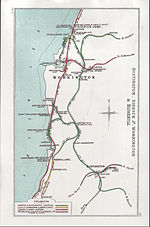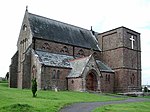High Harrington railway station
Disused railway stations in CumbriaFormer Cleator and Workington Junction Railway stationsPages with no open date in Infobox stationRailway stations in Great Britain closed in 1931Railway stations in Great Britain opened in 1879 ... and 1 more
Use British English from February 2018

High Harrington railway station was opened by the Cleator and Workington Junction Railway (C&WJR) in 1879. It was situated half a mile south of Harrington Junction on the company's main line. and served what was then the eastern extremity of Harrington in Cumbria, England. The station is not to be confused with the current Harrington station a kilometre away on the coastal line.
Excerpt from the Wikipedia article High Harrington railway station (License: CC BY-SA 3.0, Authors, Images).High Harrington railway station
Main Road,
Geographical coordinates (GPS) Address Nearby Places Show on map
Geographical coordinates (GPS)
| Latitude | Longitude |
|---|---|
| N 54.6149 ° | E -3.5508 ° |
Address
Main Road
CA14 4LL , Salterbeck
England, United Kingdom
Open on Google Maps







